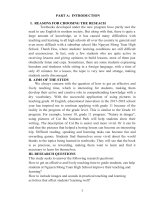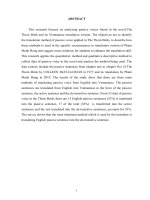The help of FDI in transferring Technology into the host countries
Bạn đang xem bản rút gọn của tài liệu. Xem và tải ngay bản đầy đủ của tài liệu tại đây (1.28 MB, 39 trang )
1
2
The help of FDI in transferring
Technology into the host countries
Group
6:
Nguyễn Thị Thu Hằng
Vũ Ngọc Huy
Đỗ Thị Lương
Nguyễn Thị Ngọc Oanh
Nguyễn Thị Phượng
OUTLINE
A
Overview
Technology transfer
Horizontal
linkages
B
4
OVERVIEW :
Intra-firm trade may account for 1/3 of total
world trade and sales of subsidiaries of
multinational firms now exceed world wide
exports of goods and services.
While
most FDI occurs between industrial
countries, developing countries are becoming
increasingly important host countries for FDI:
27% of the global stock of FDI today
is in developing countries.
5
DEVELOPING COUNTRIES
BENEFITS FROM FDI
HUMAN CAPITAL
DEVELOPMENT
COMPETITIVE
BUSINESS
ENVIRONMENT
ALLEVIATE
POVERTY
TRANSFER
TECHNOLODY
ECONOMIC
DEVELOPMENT
INTERNATIONAL
TRADE
INTEGRATION
TAX REVENUES
6
DEVELOPING COUNTRIES
MNCS: MORE ADVANCED TECHNOLOGY
PROCESS MUCH-NEEDED
AND ADVANCED TECHNOLOGY
=> LOWER PRODUCTION COST
HOW
IMPORTANT
IS TECHNOLOGY
TRANSFER
FROM FDI? SUBSIDIARIES OF MNC & DOMECTIC FIRMS
ACQUIRE TECHNOLOGY MORE DIRECTLY
AND EFFECTIVELY.
7
DEVELOPING COUNTRIES
HOW
IMPORTANT
IS TECHNOLOGY
TRANSFER
FROM FDI?
REDUCE TECHNOLOGY GAP
AMONG COUNTRIES
DECREASE SPENDING FOR
IMPORTING TECHNOLOGY.
8
DEVELOPED COUNTRIES
MNCS
take advantage of comparative advantage in
developing countries: labor resource, material
resources……
Technology develops so quickly in developed
countries.
=> Lengthen the longevity of technology.
9
VIET NAM
The
technology of Vietnam is as 50-100%
underdeveloped as developed countries.
=> FDI is very necessary.
Until
2005, more than 70% of projects involve
technology transfer.
Fields:
industry (50.7%), agricultural (5.3%),
services (2.3%), others: 41.75%. 90% of
technology transfer is through FDI.
10
Develop
important fields: exploiting
petrol,
producing
cement,
steel,
automobile,
sheep,
international
communication, modern hotels.
Import
modern
production line.
technology
and
11
Technology
transfer
Vertical
linkages
Horizontal
linkages
Labor
migration
Internationa
- lization
of R& D
12
Vertical Linkage
Aka
Backward linkages
The
strongest proof for positive spillover of tech
transfer
With
local suppliers in developing country
Buying
and selling relationships, exchange
knowledge, information and technical, financial and
business services -> raise the suppliers’ products
13
MNEs -> Local suppliers
Provide
Help
technical assistance, training, info
purchasing raw materials, intermediate goods
Modernize
and upgrade production facilities
MNE: reduce production costs
Local firms: higher tech transfer, higher demand
14
Case: Toyota Vietnam Auto Corp
Parts
Manufacturer
15
Year
Electric wires
SUMI - HANEL Sài Đồng B - Thạch Bàn - Gia
1997
Lâm - Hà Nội
Electric wires
YAZAKI - Việt Nam An Bình - Thuận An -
1998
Bình Dương
Safety glass
NSG Đáp Cầu - Bắc Ninh
1998
Supporting tools
(EMTC) 299 Tây Sơn str - Đống Đa - Hà Nội
1998
Case
TAKANICHI - Hà Nội Phúc Thắng - Mê Linh
1998
Side cover
- Vĩnh Phúc
Antenna
HARADA - Việt Nam Biên Hoà - Đồng Nai
1999
Radio
Ánh sao Co. 90 Láng Avenue - Hà Nội
1999
DMC Brake
DAMECO 129 Tôn Đức Thắng - Đà Nẵng
2000
16
2.
Horizontal
linkages
„ competing of
companies
in the same
industry.
17
18
What is DEMONSTRATION
EFFECTS?
=> The “imitation” channel of spillover
or “learning-by-watching” effect (Jutta
Gunther, 2002).
19
DEMONSTRATION EFFECTS
•MNCs
New tech.
introduction
Tech.
immitation
• Host
country
(foreign
firms)
• Domestic
firms
Production
improvements
20
What is COMPETITION EFFECTS?
=> FDI's indirect impact
on host country
efficiency and
innovation through
intensified competition.
21
MNCs’ entry into the
host country market
=> increase host
country competition.
To stay competitive,
domestic firms are
forced to operate
more efficiently and
introduce new
technologies.
=>
develop
(research
development).
R&D
and
COMPETITION
EFFECTS
22
The case of LEVI’S and
GENOVA
GENOVA
Levi Strauss & Co. from
U.S.
In Viet nam: Khanh Phu
Industrial Zone, Ninh
Binh
Tuan
Kiet Limited
Company from
Vietnam.
23
Through migration of skilled labour
knowledge
or technology transfers are a
primary way for developing countries to
benefit from high skilled emigrants
a
reduction in the number of educated
workers who are critical to productivity and a
developing country is economic growth and
an increase economic growth
Return
migrants
Expatriates
Observers
25
1. Return migrants
bring back skills and work experience from abroad.
retain connections and networks back to their home
country. When these networks are fostered they
can yield a flow back of knowledge and new
technologies that can boost source country growth.
=> Boost productivity









